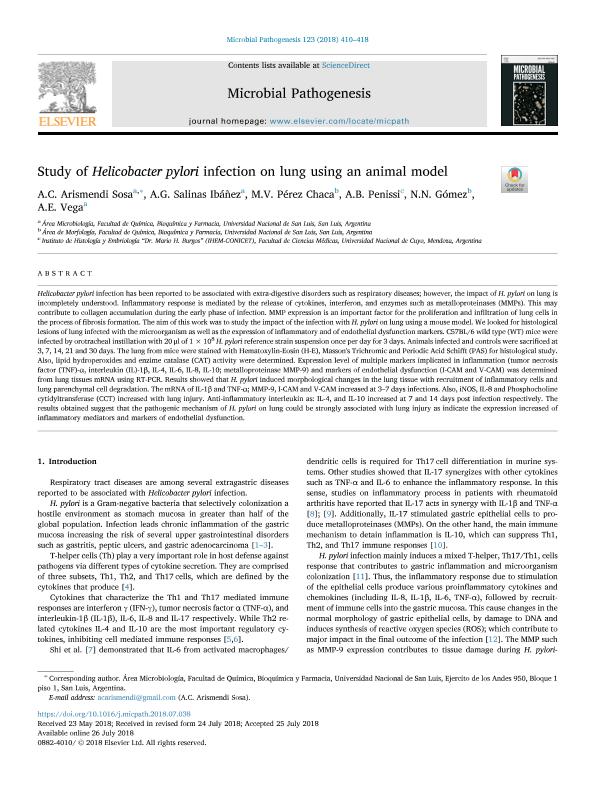Artículo
Study of Helicobacter pylori infection on lung using an animal model
Arismendi Sosa, Andrea Celeste ; Salinas Ibañez, Angel Gabriel; Perez Chaca, Maria Valeria
; Salinas Ibañez, Angel Gabriel; Perez Chaca, Maria Valeria ; Penissi, Alicia Beatriz
; Penissi, Alicia Beatriz ; Gomez, Nidia Noemí; Vega, Alba Edith
; Gomez, Nidia Noemí; Vega, Alba Edith
 ; Salinas Ibañez, Angel Gabriel; Perez Chaca, Maria Valeria
; Salinas Ibañez, Angel Gabriel; Perez Chaca, Maria Valeria ; Penissi, Alicia Beatriz
; Penissi, Alicia Beatriz ; Gomez, Nidia Noemí; Vega, Alba Edith
; Gomez, Nidia Noemí; Vega, Alba Edith
Fecha de publicación:
10/2018
Editorial:
Elsevier
Revista:
Microbial Pathogenesis
ISSN:
0882-4010
Idioma:
Inglés
Tipo de recurso:
Artículo publicado
Clasificación temática:
Resumen
Helicobacter pylori infection has been reported to be associated with extra-digestive disorders such as respiratory diseases; however, the impact of H. pylori on lung is incompletely understood. Inflammatory response is mediated by the release of cytokines, interferon, and enzymes such as metalloproteinases (MMPs). This may contribute to collagen accumulation during the early phase of infection. MMP expression is an important factor for the proliferation and infiltration of lung cells in the process of fibrosis formation. The aim of this work was to study the impact of the infection with H. pylori on lung using a mouse model. We looked for histological lesions of lung infected with the microorganism as well as the expression of inflammatory and of endothelial dysfunction markers. C57BL/6 wild type (WT) mice were infected by orotracheal instillation with 20 μl of 1 × 108 H. pylori reference strain suspension once per day for 3 days. Animals infected and controls were sacrificed at 3, 7, 14, 21 and 30 days. The lung from mice were stained with Hematoxylin-Eosin (H-E), Masson's Trichromic and Periodic Acid Schifft (PAS) for histological study. Also, lipid hydroperoxides and enzime catalase (CAT) activity were determined. Expression level of multiple markers implicated in inflammation (tumor necrosis factor (TNF)-α interleukin (IL)-1β IL-4, IL-6, IL-8, IL-10; metalloproteinase MMP-9) and markers of endothelial dysfunction (I-CAM and V-CAM) was determined from lung tissues mRNA using RT-PCR. Results showed that H. pylori induced morphological changes in the lung tissue with recruitment of inflammatory cells and lung parenchymal cell degradation. The mRNA of IL-1β and TNF-α; MMP-9, I-CAM and V-CAM increased at 3–7 days infections. Also, iNOS, IL-8 and Phosphocholine cytidyltransferase (CCT) increased with lung injury. Anti-inflammatory interleukin as: IL-4, and IL-10 increased at 7 and 14 days post infection respectively. The results obtained suggest that the pathogenic mechanism of H. pylori on lung could be strongly associated with lung injury as indicate the expression increased of inflammatory mediators and markers of endothelial dysfunction.
Palabras clave:
HELICOBACTER PYLORI
,
LUNG
Archivos asociados
Licencia
Identificadores
Colecciones
Articulos(IHEM)
Articulos de INST. HISTOLOGIA Y EMBRIOLOGIA DE MEND DR.M.BURGOS
Articulos de INST. HISTOLOGIA Y EMBRIOLOGIA DE MEND DR.M.BURGOS
Citación
Arismendi Sosa, Andrea Celeste; Salinas Ibañez, Angel Gabriel; Perez Chaca, Maria Valeria; Penissi, Alicia Beatriz; Gomez, Nidia Noemí; et al.; Study of Helicobacter pylori infection on lung using an animal model; Elsevier; Microbial Pathogenesis; 123; 10-2018; 410-418
Compartir
Altmétricas



